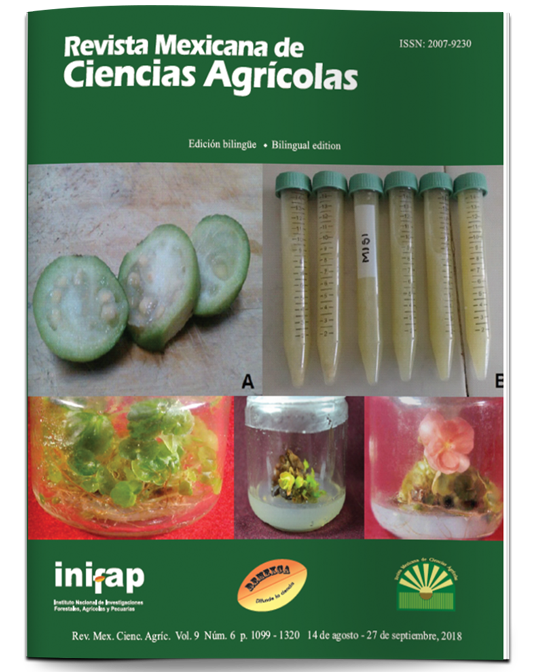Morphological diversity of piquin chilli (Capsicum annuum L. var. glabriusculum) from Querétaro and Guanajuato, Mexico
DOI:
https://doi.org/10.29312/remexca.v9i6.1581Keywords:
morphological characterization, native plant, variation, wild populationsAbstract
In the present investigation, the morphological variability of 11 populations of wild piquin chili (Capsicum annuum var. glabriusculum) of the Mountain range Gorda and Semidesert of Queretaro (Municipalities of Arroyo Seco, Jalpan of Serra, Toliman and Cadereyta de Montes) and Guanajuato (Municipality of Xichu). The characterization was carried out under greenhouse conditions at the Technological Institute of Roque (ITR) located in Celaya, Guanajuato, Mexico. The 44 characters were recorded in seedling, plant, flowering, fruit maturity and seed. The principal component analysis (CP) showed that the first three components explained 56.6% of the total morphological variability. The CP1 was explained by the characteristics of weight (0.326), width (0.301) and fruit length (0.271), leaf density (0.277) and seed diameter (0.297). In CP2, the variables that contributed most to the expression of the variation were width (0.329) and leaf pubescence (0.317) and finally, in CP3, the shape of the fruit (0.344) and color of the anthers (-0.308) were the most important characters. On the other hand, the cluster analysis generated four groups, group I included the G3 (Rosa of Castilla), G2 (Palmitas The Tanque), G1 (The Tanque) populations, all of the Mountain range Gorda in Guanajuato. Group II was made up of population Q7 (The Patol, Querétaro). Group III was formed by population Q5 (Presa Jalpan, Querétaro) and finally, group IV was integrated by six populations, Q4 (San Antonio Tancoyol), Q8 (Higuerillas stream), Q6 (Higuerillas The Shote), Q2 (The Refugio solar-huerta), Q3 (Tancoyol Road to Tancoyol) and Q1 (The Chilar Refuge), all of the State of Querétaro. The morphological diversity found in this species tells us that this native plant should be conserved and that it can be easily integrated into a program of sustainable use of the flora of the region.
Downloads
Downloads
Published
How to Cite
Issue
Section
License
The authors who publish in Revista Mexicana de Ciencias Agrícolas accept the following conditions:
In accordance with copyright laws, Revista Mexicana de Ciencias Agrícolas recognizes and respects the authors’ moral right and ownership of property rights which will be transferred to the journal for dissemination in open access. Invariably, all the authors have to sign a letter of transfer of property rights and of originality of the article to Instituto Nacional de Investigaciones Forestales, Agrícolas y Pecuarias (INIFAP) [National Institute of Forestry, Agricultural and Livestock Research]. The author(s) must pay a fee for the reception of articles before proceeding to editorial review.
All the texts published by Revista Mexicana de Ciencias Agrícolas —with no exception— are distributed under a Creative Commons License Attribution-NonCommercial 4.0 International (CC BY-NC 4.0), which allows third parties to use the publication as long as the work’s authorship and its first publication in this journal are mentioned.
The author(s) can enter into independent and additional contractual agreements for the nonexclusive distribution of the version of the article published in Revista Mexicana de Ciencias Agrícolas (for example include it into an institutional repository or publish it in a book) as long as it is clearly and explicitly indicated that the work was published for the first time in Revista Mexicana de Ciencias Agrícolas.
For all the above, the authors shall send the Letter-transfer of Property Rights for the first publication duly filled in and signed by the author(s). This form must be sent as a PDF file to: revista_atm@yahoo.com.mx; cienciasagricola@inifap.gob.mx; remexca2017@gmail.
This work is licensed under a Creative Commons Attribution-Noncommercial 4.0 International license.



